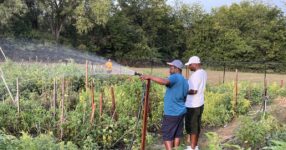
Gardeners in Waterloo are adapting African crops for Iowa’s climate — and feeding the community
Justin Songe waters what look like fluffy pastel clumps on his Highland Park Community Garden plot. They toss peppery pollen in the air as they shake; it smells almost smoky. In Congolese French, he hollers for a neighbor’s help in pinning down what it tastes like in English.
He’s watering amaranth, one of seven native Congolese crops that he and his community are raising on the several acres they farm. He pokes around a low cluster of cuddling sweet potato vines. For them, the garden is necessary for the health of the community.
“We have to think about how we can eat something very biological,” Songe said. “That’s why we do the garden. To save our lives and our family’s lives.

Grant Leo Winterer
/
Iowa Public Radio
Troubles cropping up
Songe and the other Congolese farmers want to grow native crops to share with their families, but it’s been a process bringing African crops into their Iowa garden. For one, the climate of the Democratic Republic of Congo and northeast Iowa couldn’t be more different. Until recently, things hadn’t been growing.
Shaffer Ridgeway, a conservationist with the USDA, has helped shape community gardens in eastern Iowa for years. He worked with the Congolese farmers in Highland Park to raise their crops.
“Some of them are tough to grow here,” Ridgeway said. “It’s cold so late, and then suddenly it gets hot, but it doesn’t stay hot long enough for the plant to reach maturity.”

Grant Leo Winterer
/
Iowa Public Radio
The DRC has a mostly tropical climate, roughly 80° year-round. It’s a world away from the Midwestern state that prides itself on near-monthly climbs and tumbles up and down the thermometer. On average, only three months each year in Iowa meet the temperature requirements for Congolese crops.
Songe has seen that firsthand. He checks the tassels of African corn fit for a folk tale. This year, it’s 20 feet tall with ears the size of footballs, but it hasn’t always been.
“Last year, I tried to grow it at home, but it didn’t give me fruit,” he said. “It went up, but no corn. Because it was from my country, we didn’t know how to grow it.”
To get the corn to grow, Songe had to learn to work with his new soil. The Congo Basin is mostly clay, making it good for rugged cash crops such as coffee and rubber, but very little else.
Northeast Iowa on the other hand, is known for what it can grow.
“The traditional Iowa soil is very black and great, especially here in this part of the state,” said Steven Eilers with Iowa State University Extension and Outreach. “A lot of the African crops are designed for sandier soil, so that very good, black, hard soil we have here isn’t always good for a lot of their crops.”
That creates a paradox for the farmers: the soil is almost too good to get anything growing.
On top of that, the farmers face a steep language barrier as newcomers to the United States, so they have relied on sharing the farming experience they bring from Congo with each other. Eilers said that experience often runs deep.
“These aren’t people who’ve never grown anything before,” he said. “These are lifetime gardeners — generations of gardeners, farmers. They have their own techniques; they just need to learn how to do it here.”
Trading farming traditions
Subsistence farming is a way of life for millions of families in the DRC. More Congolese families in Waterloo are bringing their knowledge to the Highland Park Community Garden. Songe said the community has helped him expand what he can grow.
“We’ve got some people who already know how to plant from my country,” Songe said. “If we have difficulty, we ask them how we can plant vegetables like we did this year.”
Those people are bringing farming traditions from the Congo and mixing them with techniques closer to Iowa.
Zachary Couture runs Global Greens, a nonprofit that provided ongoing agricultural education to the Highland Park gardeners. He stands over a huge patch of flourishing greens and scattered gourds under cover of agriculture’s famous “three sisters.”
“The main three are corn, beans and squash,” Couture said. “And there’s spacing techniques you can use to get more of a harvest of corn or beans, but people do, like, 60 sisters here.”
The farmers at Highland Park have adopted the technique and added their own crops to the mix. Tucking low-growth Congolese greens underneath those domestic vegetables has provided moisture retention for Congolese crops, bringing growing conditions closer to those in the Congo Basin with enough regular watering.
The fruits — and flowers — of their labor
There’s also just enough room for flowers.
Julie Molisho planted some of the first seeds in Highland Park two seasons ago. Her plot is dotted with marigolds for pest control. She avoids spraying insecticides since she’ll end up eating many of the leaves of the crops, not the roots.
In addition to what they eat themselves, the farmers have sold around 15,000 pounds of produce to the area’s food banks this year. Molisho credits that success to the experience traded between farmers over those two years.
“I feel like they’ve been helping them to grow some foods, and just teaching them the gardening techniques here in America,” Molisho said.

Grant Leo Winterer
/
Iowa Public Radio
At a potluck celebrating the season’s success, Molisho unrolls tinfoil from a dish of fragrant amaranth, sweet, stewed cassava leaves and small, ivory eggplants roasted so slowly they look asleep. The fruits of her labor.
“Everything here grew there,” she said. “Today, I can eat amaranth, tomorrow spinach and the day after cassava leaves.”
And most importantly, there’s plenty for everyone.



